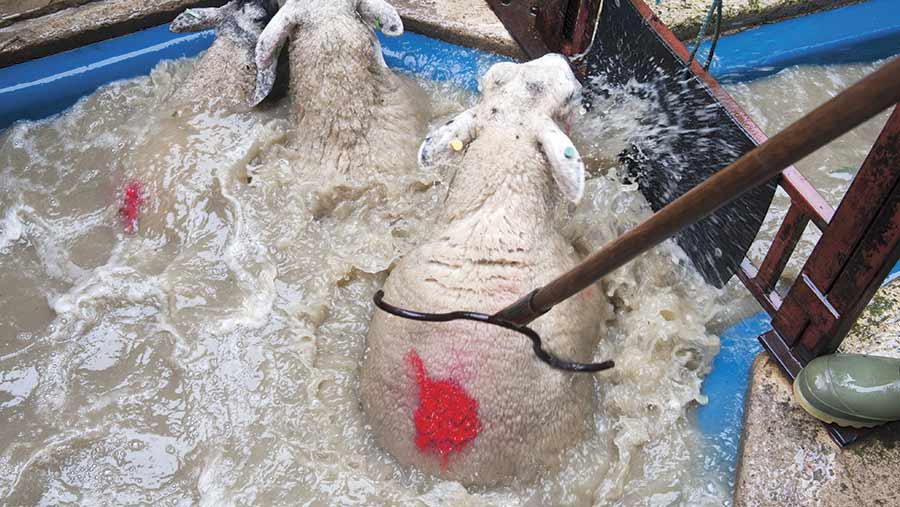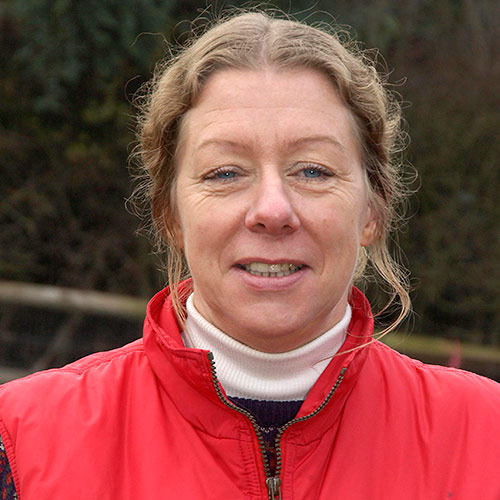Test and dip is best approach for national scab control
 © FLPA/Wayne Hutchinson/REX/Shutterstock
© FLPA/Wayne Hutchinson/REX/Shutterstock The UK sheep industry should combine a new Elisa scab test with plunge dipping in organophosphate (OP), as it is the best way to control sheep scab and other ectoparasites.
This is the advice from Peter Bates of the Veterinary Medical Entomology Consultancy and independent sheep consultant Lesley Stubbings following the first confirmed resistance to class 3 injectables on flocks in Herefordshire and Wales.
See also: Complete our Scab in sheep Academy

Lesley Stubbings ©John Eveson
They have reminded farmers and contract dippers that other methods of administering OP (sprayers/showers/jetters) are illegal, with diazinon products only licensed for plunge-dipping.
However, confirmation of resistance to injectables does not mean they are to be removed from the medicine cabinet, as they have their purposes, such as quarantining and treating a small number of animals.) But they will need to be used judiciously to safeguard them for future scab and worm control.
Addressing the inaugural Scab Control Awareness with Bimeda event at St Helens last week, Dr Bates and Mrs Stubbings said scab mite resistance to the endectocide moxidectin (injectable scab and wormer treatment) should be a catalyst for a return to dipping where appropriate.
Consider plunge dipping
Mrs Stubbings said OP plunge dipping alongside the new Elisa scab test, launched by Biobest last May, were two key tools needed to find and treat subclinical cases early.
“Early identification of scab is so important and this test allows farmers to identify scab before the sheep start itching,” said Mrs Stubbings. “The test is a game changer because by the time a farmer sees clinical signs of scab, about 50% of the flock can already be infected.”
Dr Peter Bates said 6-80% of the flock could be infected by the time the farmer calls the vet out.
He said: “Plunge dipping has been around for 150 years and I think it is the best mode of parasite control we have. A mobile dipping contractor will remove almost all of the issues and problems that plunge dipping brings.”
|
Advantages of plunge dipping |
Disadvantages of plunge dipping |
|
|
Four ways to keep injectables working
- Ensure best practice: Weigh animals and make sure they are injected properly
- Use OPs only as plunge dips
- Report the lack of efficacy. Raise the profile and make sure the powers that be know we have an issue.
- Encourage diagnosis – enzyme-linked immunosorbent assay (Elisa) test.
Mr Stubbings said: “We don’t want to scrap MLs. We want to rely on MLs less and use OP dipping more. We aren’t just talking about scab control; we are talking about the life of MLs and making them useful as a tool in the future.”
Three things to consider for good dipping
- Volume: Accurate volume must be known to mix dip solution correctly. Most dips are 900-2,250 litres.
- Time: A full minute is essential for absorption of the dip. Failure to achieve one minute immersion can cut scab cure by 60%. In tests, a 40-second immersion led to 38% less absorption than one minute.
- Replenish: Depending on the size and breed of the flock and fleece length, sheep can remove 18-32 litres of dip wash, retaining 1-4.5 litres in the fleece. 200 ewes can remove 200-900 litres, therefore dip solution (both active and water) must be replaced.
Flocks in the West show first scab resistance
Sheep scab mites are developing resistance to class 3 macrocylic lactones (MLs), a study published in Vet Record has confirmed.
Four flocks showed signs of resistance when treated for sheep scab (ovine psoroptic mange) with an endectocide moxidectin injection, also licensed to address worms.
The revelation, while a concern, was likely given the similarities in modes of action across the range of parasites (roundworms, lungworms, eyeworms, warbles, lice and mange mites), the study concluded.
Industry records show endectocide and pour-on use has risen sharply since compulsory dipping ended in 1992, with injectables believed to account for 85-95% of scab treatments.
The farmers had reported scab treatment failure on the four farms, of which two were in west Wales, one on the Welsh/English border and one in Herefordshire.
Elisa scab test facts
- How do I do it? Veterinary assistance will be required to take blood samples.
- What will it cost? £72 for a 12-sheep test as recommended by flock health experts. 2-11 samples = £11, individual = £9.50.
- How long does it take? Biobest laboratory, Edinburgh, runs weekly tests on Wednesday/Thursday, with results expected to be back to the farm by Wednesday night/Thursday morning.
- Why bother? This test confirms scab early at subclinical stages of the condition before sheep itch and scratch. Save money on OP or ML treatments if unnecessary and relieve resistance pressure on scab and worms.
